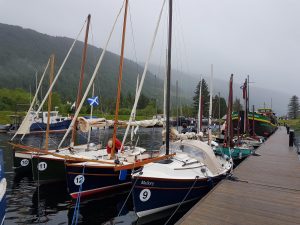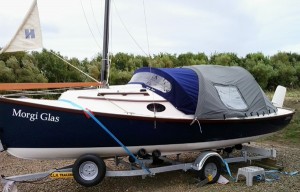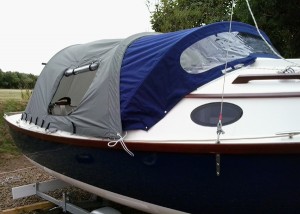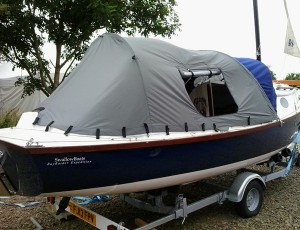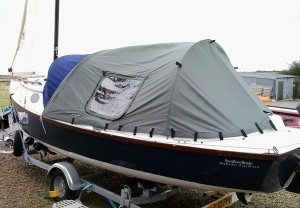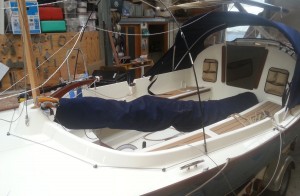Reluctantly for sale after a family move, and presently lying ashore at Cowes. If interested, please email jane.cornah@gmail.com for full specification and price.
BR20 Askari in Norway
Bill Rollo and Matthew Peacock.
An account of Askari’s voyage up the Helgeland coast from Bronnøysund to Bodø 4th-21st Aug 2019.
After our 2018 venture up the West Coast of Sweden a further expedition to Northern Norway in 2019 was a natural progression. Reading from other trips – from Frank Dye’s Northern voyage (not his passage across the North Sea) to the intrepid Poles who went from Trondheim to Bodo in their Salmo 15s in foul weather – and the history books, all pointed us towards the Helgeland Coast. The only real issue was how to get there within the available time. After considerable efforts to find a way of shipping the boat (Askari, a 20 foot Bayraider 20), and ideally the car, trailer and crew, to Norway (the Bergen ferry no longer runs) we decided that the only answer was to say ‘Sod it’ and drive. Once there we would park the car, launch the boat, sail as far North as we could for 17 days, and then use the excellent Norwegian ferry or air system to retrieve the car, recover the boat and drive back.
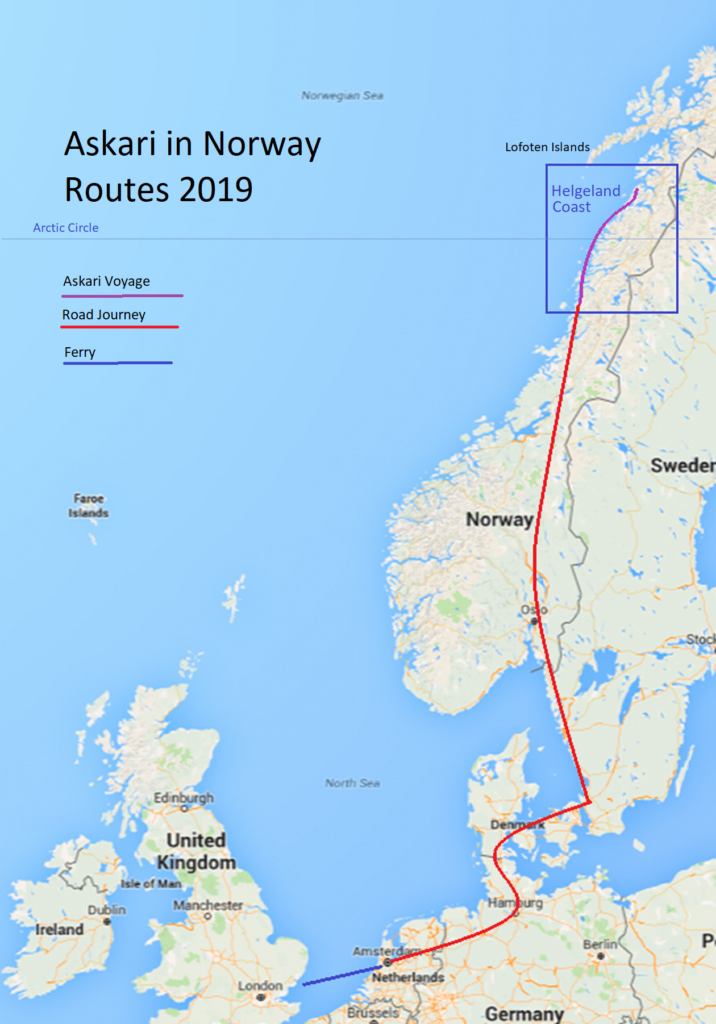
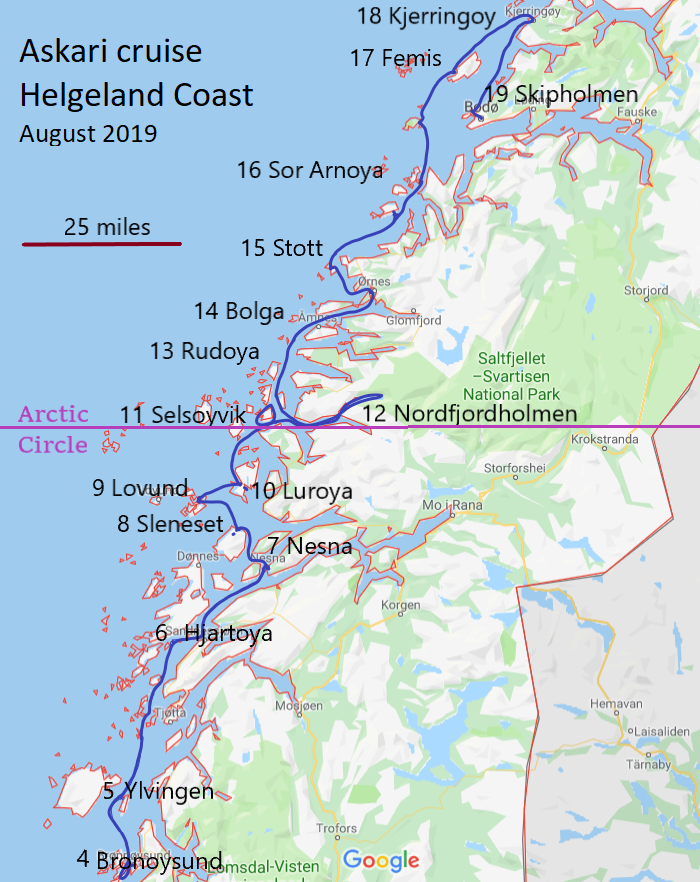
1st – 3rd August Hook of Holland – Bronnoysund
Rather to our surprise the plan worked liked a dream. We left the Hook of Holland at 6pm on the evening of Thursday 1st August, hit the Danish border that night, missing the bulk of the German traffic around Hamburg, and were North of Oslo by Friday evening.
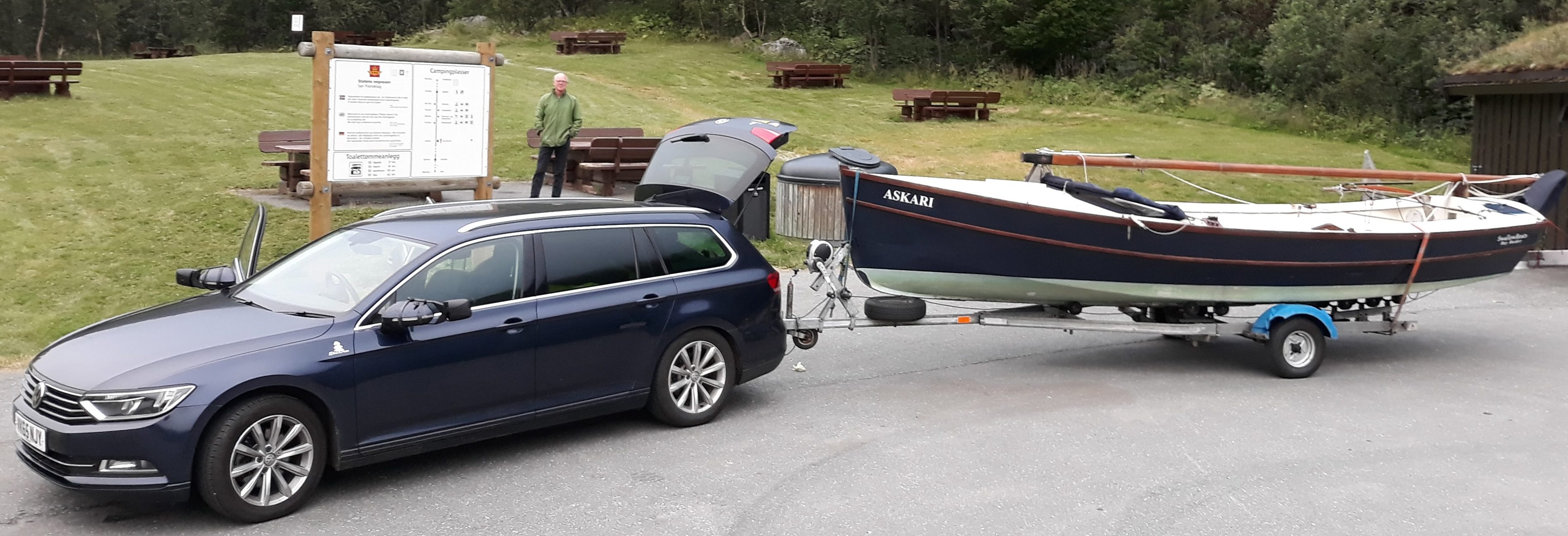
We reached our destination – Bronnoysund – after a further long but interesting drive over the mountains on Saturday night, and found the parking and slip recommended by the helpful harbour master in a previous email exchange to be exactly as indicated.
4th Aug Bronnoysund
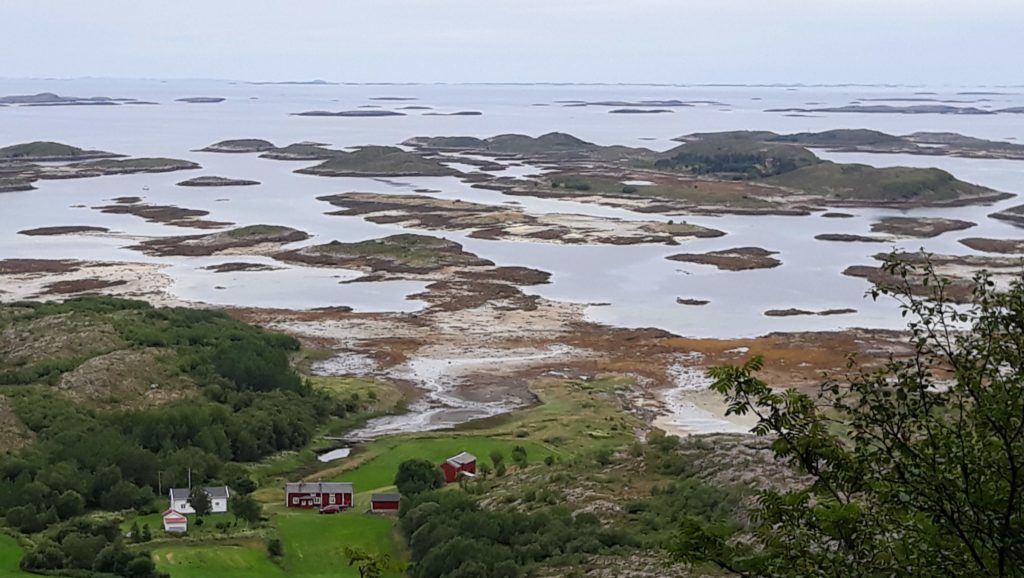 We launched at high water at 4am and promptly sailed and motored down to Torghatten to have our first encounter with Norwegian paths (wheelchair accessibility not a priority) climb up to the vast cave which goes through the mountain and then return to Bronnoysund to get final supplies on Monday morning.
We launched at high water at 4am and promptly sailed and motored down to Torghatten to have our first encounter with Norwegian paths (wheelchair accessibility not a priority) climb up to the vast cave which goes through the mountain and then return to Bronnoysund to get final supplies on Monday morning.
5th Aug Ylvingen
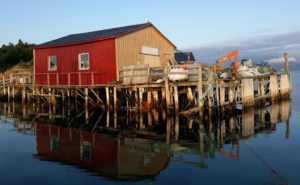 By Monday afternoon we were tacking North in a light Northerly to the island of Ylvingen, famous in Norway as the setting for an immensely popular TV show, but now, by early August, already closing down for the winter. A walk to inspect the German coastal defence positions also revealed 2 Elk, who we learned were part of a population of 60 which had swum across from the mainland. Our Norwegian contact, with the prospect of a freezer full of elk meat clearly in mind, told us that there would be only 20 by next summer.
By Monday afternoon we were tacking North in a light Northerly to the island of Ylvingen, famous in Norway as the setting for an immensely popular TV show, but now, by early August, already closing down for the winter. A walk to inspect the German coastal defence positions also revealed 2 Elk, who we learned were part of a population of 60 which had swum across from the mainland. Our Norwegian contact, with the prospect of a freezer full of elk meat clearly in mind, told us that there would be only 20 by next summer.
6th Aug Hjartoya
With a more favourable wind next day we were able to make good progress, stopping for coffee in an interesting anchorage in the skerries, complete with sea eagles, before going on to visit the beautifully executed modern museum to a local Norwegian cleric – Petter Dass – at the bottom of Alsta. Our guides to the church and rectory included a girl who while expert in her history was even more expert in every form of fish and fishing.
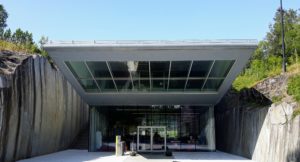
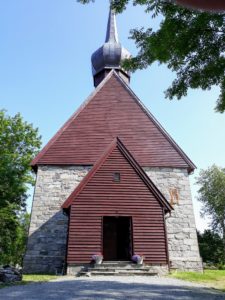
We ended the day in the perfect anchorage at Hjartoya, underneath the peaks of Donna and looking back towards the 7 Sisters of Alsta.
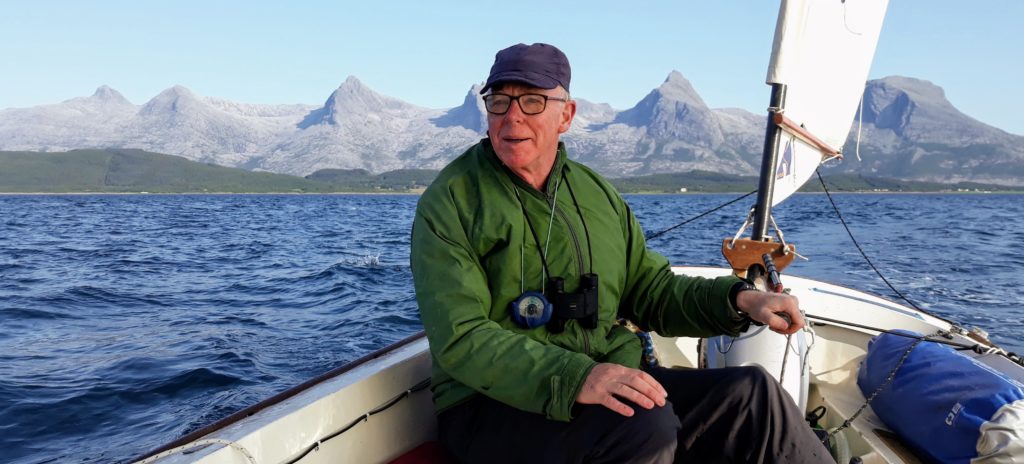
7th Aug Nesna
Next morning we motored across to Sandnessjoen before sailing gently up past Lokta and Hugla to the small sailing town of Nesna, where we were able to make use of the excellent facilities provided at modest cost by the local Batforening. In contrast to Sweden, where the automated system was firmly policed by harbour maidens, the Norwegian one relied totally on honesty, whether payment was made by app, or more often, through an honesty box.
8th Aug Slenset
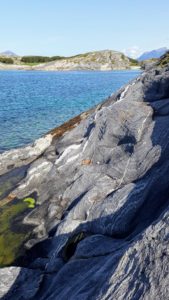 A wonderful day. Armed with a local recommendation we went around the North side of Tomma to find a small and perfect beach tucked in behind dramatic rocks.
A wonderful day. Armed with a local recommendation we went around the North side of Tomma to find a small and perfect beach tucked in behind dramatic rocks.
After an extended break and walk we sailed up through the skerries to the small harbour of Sleneset, at the centre of an enormous archipelago, much of it restricted as a nature reserve.
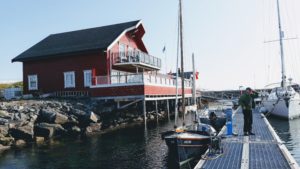
9th Aug Lovund
A more favourable wind next day blew us rapidly out to the dramatically shaped island of Lovund, allegedly home to a huge population of puffins. Every entreaty possible was made to dissuade the visitor from disturbing the population, ending with a dramatic warning that the birds were infested with blood sucking parasites.
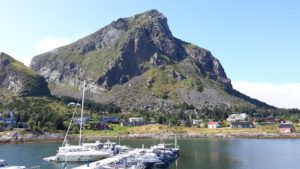
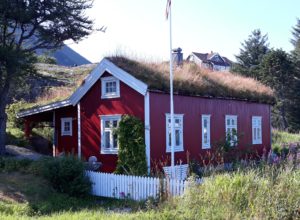
10th Aug Luroya
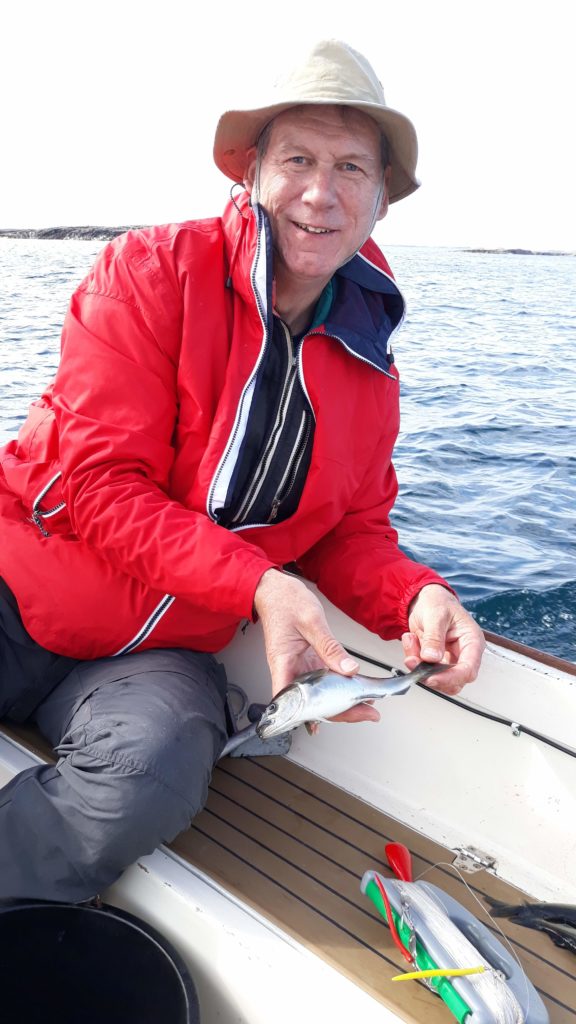 With the prospect of a change in the weather we reluctantly resisted the temptation to go a further 10 miles out to the islands around Traena, and worked our way back in towards the coast, breaking to fish, before turning North into the narrow channel that runs up between Luroya and Stigen.
With the prospect of a change in the weather we reluctantly resisted the temptation to go a further 10 miles out to the islands around Traena, and worked our way back in towards the coast, breaking to fish, before turning North into the narrow channel that runs up between Luroya and Stigen.
With the pilot recommended anchorage invaded by an industrial concern we found a smaller but entirely adequate bay a little further North, ready for the forecast fresh South Easterlies next day. Matthew turned his 6 beautiful pollock into protein in a dramatic display of culinary determination.
11th Aug Selsøyvik
The promised South Easterlies arrived on the dot and we shot North with increasing speed, hitting 7.2 knots before reefing as we headed up to the Arctic Circle monument at Vikingen.
Here our luck turned. Our intention had been to continue East into Melfjord and onto the Nordfjord where the Svartisen Glacier comes down towards the sea. Unfortunately our South Easterly was now channelled down a different valley system and from being nicely astern moved to being right on the nose, strengthening sharply as it did so.
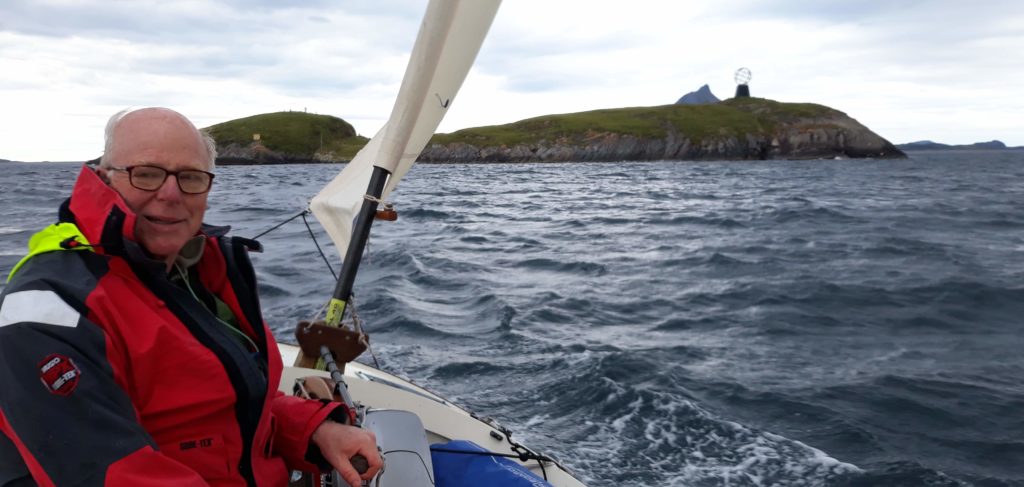
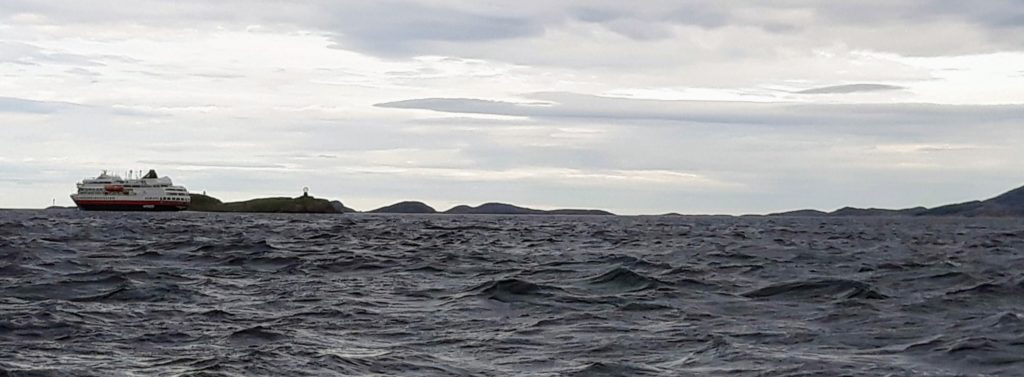
The Hurtigruten ferry was then treated to a fine view of the mad English dropping the main rather hurriedly. Luckily they were not privy to the internal discussion as the crew, complained that his photograph had mysteriously grown ears and we would need to go twice around the island to get a better shot. This resulted in an outbreak of grim determination from the skipper and we spent the next hour crawling up to the mouth of the Melfjord, only to discover even blacker clouds and stronger winds. A rapid change of plan saw us turn North, run up the East side of Gjerdoya, and then turn into the sheltered sound leading down to Selsøyvik.

Selsøyvik was a find. The place itself was a small but handsome 18th century trading station on a much older site, lovingly restored and now supported by a holiday business and an island shop of quite remarkable quality. Here also we first encountered Thorun and his family, who was a mine of accurate and useful information on small bays and anchorages suitable for our boat, and who we would meet repeatedly over the next 10 days in a slightly tortoise and hare type fashion.
12th Aug Nordfjordholmen
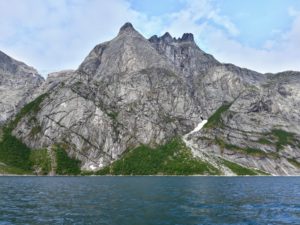 Next day the wind had moderated and we were able to make our way up to the head of the Nordfjord, a wild and lonely place where we were surrounded by peaks and waterfalls from the glacier above. Aside from its beauty this was remarkable for two other reasons. It was the only place, deep in a national park, where we did not have a phone signal. And we saw our first and only seals; shy and cautious beasts who barely raised their heads above the water, quite unlike the confident and voracious animals we had admired en masse on Mingulay earlier in the summer. Whenever we raised the topic locally we were told that there were many in the South of Norway, but that here they did not mix well with the fish…
Next day the wind had moderated and we were able to make our way up to the head of the Nordfjord, a wild and lonely place where we were surrounded by peaks and waterfalls from the glacier above. Aside from its beauty this was remarkable for two other reasons. It was the only place, deep in a national park, where we did not have a phone signal. And we saw our first and only seals; shy and cautious beasts who barely raised their heads above the water, quite unlike the confident and voracious animals we had admired en masse on Mingulay earlier in the summer. Whenever we raised the topic locally we were told that there were many in the South of Norway, but that here they did not mix well with the fish…
13th Aug Rodoya
After a quiet night in another classic anchorage at Norfjordholmen we sailed out to Renga, where we walked up to the caves used by some exceptionally tough and brave Norwegian resistance to monitor coastal traffic for nearly 2 years, and then went on to Rodoya, and the very upmarket restaurant and B&B at Klottergarten where we spent a rather bumpy n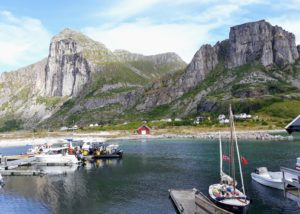 ight on a pontoon as the wind went around to the West. A RIB with not one but two 300HP outboards gave us a glimpse of other options to move around the islands, while another chance encounter gave us the best boat name so far: Malik – apparently the crest of a breaking wave in Greenland – seemed a great name for a sleek grey RM 45 returning to Tromso from a summer trip to the Canaries.
ight on a pontoon as the wind went around to the West. A RIB with not one but two 300HP outboards gave us a glimpse of other options to move around the islands, while another chance encounter gave us the best boat name so far: Malik – apparently the crest of a breaking wave in Greenland – seemed a great name for a sleek grey RM 45 returning to Tromso from a summer trip to the Canaries.
14th Aug Bolga
The same wind which gave us an uncomfortable night gave us a lovely sail next morning, past the beaches West of Rodoya, through the skerries East of Svinvaer and up to Bolga where we found yet another fine Norwegian path up on to the ridge before deciding that Crocs and sandals probably did not pass the common sense test for a further trip up to the top.
15th Aug Stott
Next morning with the wind still in the West but gentler we had a straightforward run in lowering cloud past Meloya and Mesoya to Ornes where we found the little museum closed but were able to re-stock in one of several supermarkets, as our original supplies were finally running low. By now we were also beginning to focus hard on a suitable weather window to get around the headland at Kunna, which has a local reputation akin to Ardnamurchan, and so decided to push on to Stott where we found ourselves the only inhabitants of another former fishing post turned restaurant and gjestehaven.
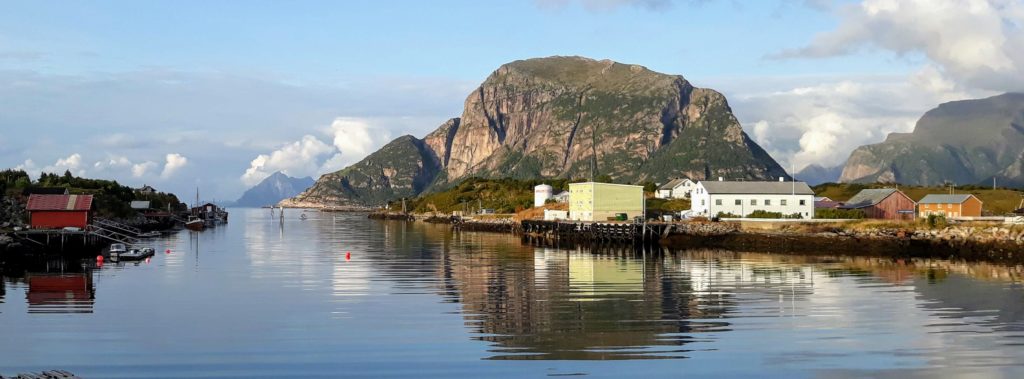
16th Aug Sor Arnoya
A lovely morning and calm conditions had us on the water early to motor a couple of miles around Kunna before hoisting sail and heading on North to Sor Fugloya, yet another majestic hump of rock and a pleasant village including a fine Nordland faering, fronting onto an equally fine white beach. Leaving there after lunch we had a brisk sail in a freshening easterly wind up to Sor Arnoya where we avoided the commercial sound by diving into the perfect pool of Krokholmen, surrounded by vast racks for drying cod and a network of rope walkways between multiple islets that together made up the harbour.
17th Aug Fenes
We were now fast approaching Bodo with a few days in hand and decided to bypass it and go further North to Kjerringoy, off the edge of the known world (or at least of our paper chart coverage).
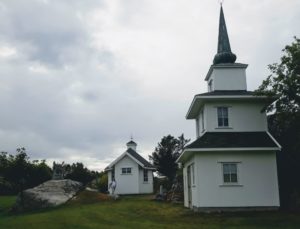
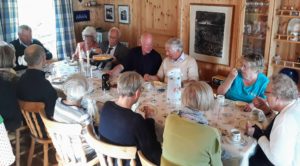 Our first stop was Bliksvaer where we arrived to find ourselves in the middle of a ceremony to celebrate the building of a new church on the island 20 years before, itself a catalyst for the revival of the island’s community. The pastor arrived suitably, sailing his own boat, the Lutheran hymns had a familiar rhythm, we admired the spire, brought in by Sea King helicopter on arch-episcopal authority, were fascinated by a small but comprehensive museum telling the tale of the loss of HMS Effingham in 1940, driving in at 23 kts through poorly charted waters, and enjoyed great hospitality and many cloudberries, in the village hall. It was only with some difficulty that we extracted ourselves for a lovely evening sail to the quiet little fishing port of Fenes on the South West tip of Landesgode.
Our first stop was Bliksvaer where we arrived to find ourselves in the middle of a ceremony to celebrate the building of a new church on the island 20 years before, itself a catalyst for the revival of the island’s community. The pastor arrived suitably, sailing his own boat, the Lutheran hymns had a familiar rhythm, we admired the spire, brought in by Sea King helicopter on arch-episcopal authority, were fascinated by a small but comprehensive museum telling the tale of the loss of HMS Effingham in 1940, driving in at 23 kts through poorly charted waters, and enjoyed great hospitality and many cloudberries, in the village hall. It was only with some difficulty that we extracted ourselves for a lovely evening sail to the quiet little fishing port of Fenes on the South West tip of Landesgode.
Kjerringoy
Next morning the improved sailing conditions continued, with the pleasant Easterly wind forecast supercharged into distinctly sporting form as it accelerated down the steep valleys between Landesgode’s mountains.
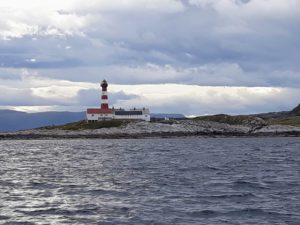
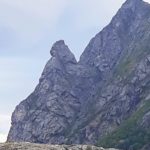
We reefed and then dropped the main on the way up to the fine light house at the North end of Landesgode before a wind shift as we cleared the shadow of the island allowed us a great reach across to Kjerringoy. Kjerringoy, with its fine museum, extensive collection of 18th century buildings and history as a major entrepôt for the fishing trade, with upto 30,00 fishermen and women waiting to cross into their fishing grounds in the 1860s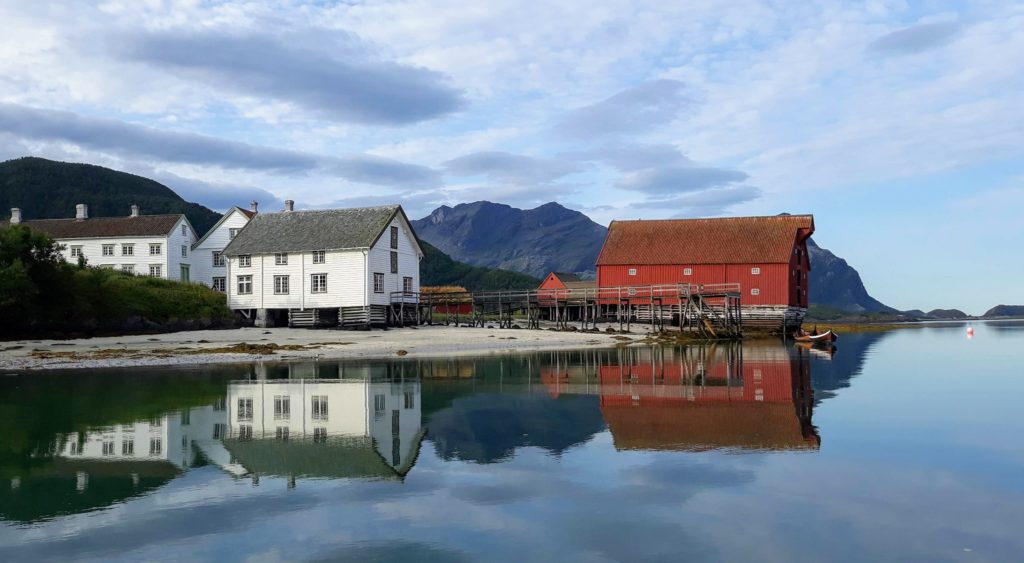 was a suitable finale to the trip. And we had two further interesting encounters: the first a remarkable lady who had recently built a beautiful Nordland Faering from 2 trees with traditional tools, giving it our second favourite boat name – Ea – a female eider duck).
was a suitable finale to the trip. And we had two further interesting encounters: the first a remarkable lady who had recently built a beautiful Nordland Faering from 2 trees with traditional tools, giving it our second favourite boat name – Ea – a female eider duck).
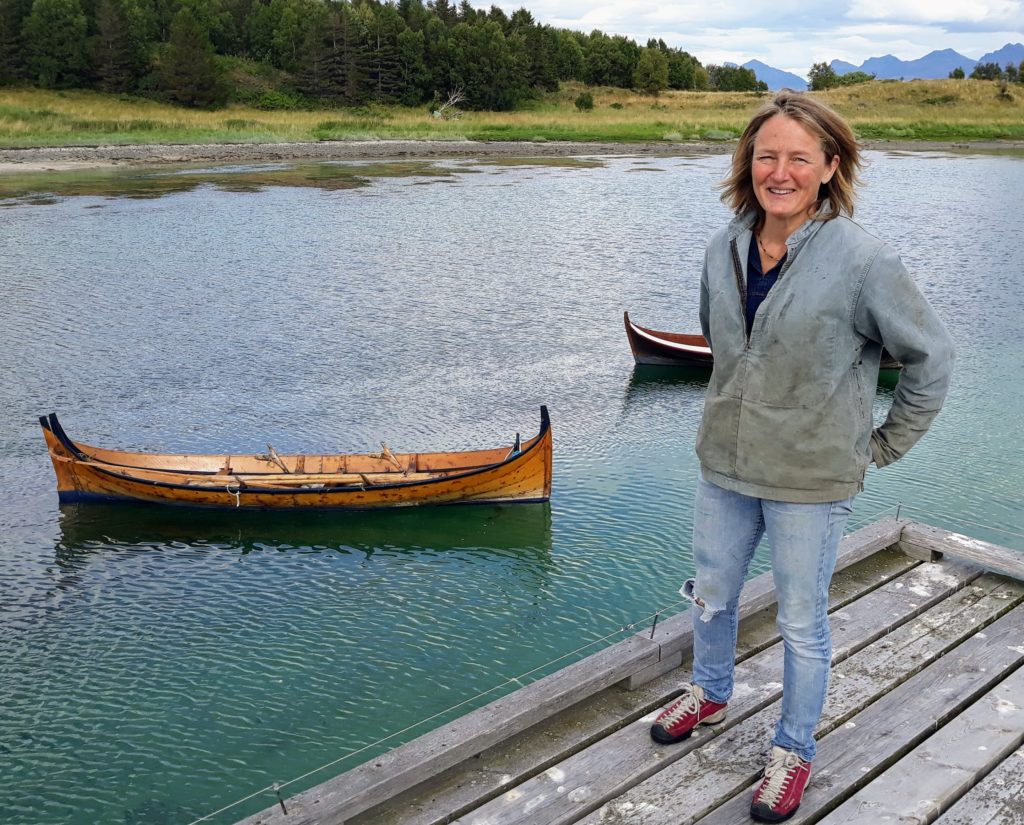
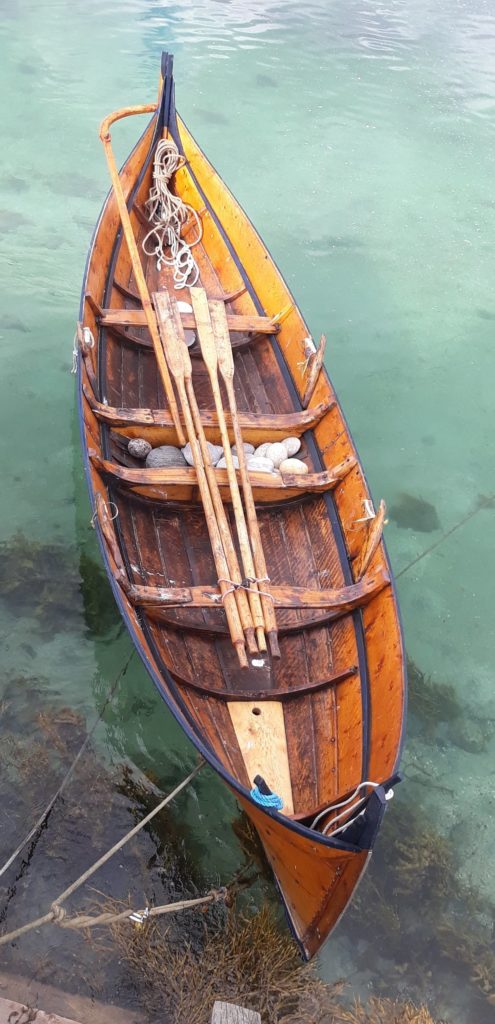
The second with the owner of Northern Quest, which had been twice around the world in 31 years of continuous ownership, an authority on the great Norwegian explorers Amundsen and Nansen,
19th Aug Skipholmen
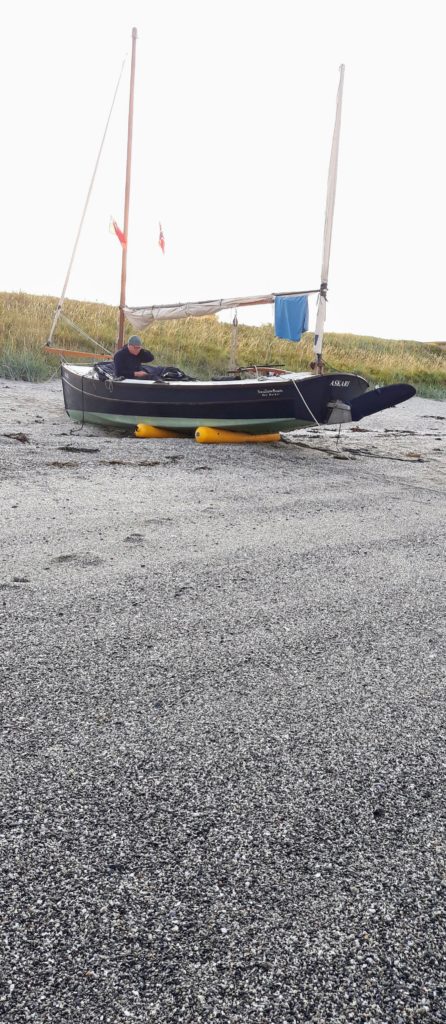 After a quick check on the tide we went quietly down the sound running South from Kjerringoy inside the coastal islets, anchoring for lunch at Vagoya and then, putting off the evil moment for as long as possible, deciding to spend our last night on the beach at Skipholmen just outside Bodo, where we put our inflatable boat rollers to the test. The rollers worked perfectly, although our technique left considerable room for improvement.
After a quick check on the tide we went quietly down the sound running South from Kjerringoy inside the coastal islets, anchoring for lunch at Vagoya and then, putting off the evil moment for as long as possible, deciding to spend our last night on the beach at Skipholmen just outside Bodo, where we put our inflatable boat rollers to the test. The rollers worked perfectly, although our technique left considerable room for improvement.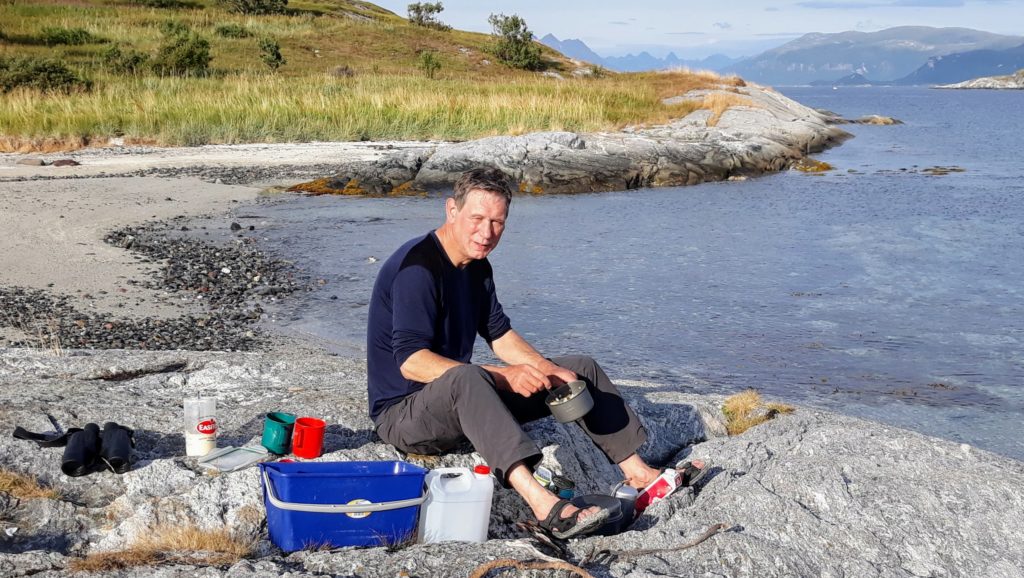
We had a quiet night above the HW line until 4 when we launched in 5 minutes before going back to sleep. Later that morning we drifted gently into Bodo. All good things come to an end.
20th – 24th Aug Bodo to Harwich
Over the following 4 days Bill flew down to Bronnoysund to retrieve the car and trailer, and we retraced our route back down to the Hook of Holland, advancing our ferry times once we knew we could safely do so, arriving back in Harwich after some 4500 miles on a quiet Sunday morning, slightly bemused that we would not be cooking breakfast and hoisting sail to continue North.

SeaRaider “Craic” wins Sail Caledonia 2017
Well done to Andrew, Graham and John, who sailed Andrew’s SeaRaider, “Craic”, to overall victory in this year’s Sail Caledonia. It was another fantastic week with generally good weather as the boats sailed and rowed from Fort William to Inverness along the Caledonian Canal and the Great Glen’s lochs.
There were 4 Swallows entered – in addition to Craic there was a BayRaider 20 (Augusta Thomasina), a Storm 17 (Peewit) and a BayRaider Expedition (Mallory). Craic dominated the Swallow class but had stiff competition from “Jack”, a Swampsott Dory, in the overall competition. Jack is a great alrounder but Craic’s superior sailing ability combined with Andrew and his crew’s excellent sailing gave them the advantage when the wind blew.
Full results and photo galleries will be available on the Sail Caledonia website shortly.
Colour Codes – Gel Coat and Paint
These are the colours Swallow Boats use on their boats.
The standard colours on the GRP boats are as follows:
RAL 9001 Cream (used for deck and under the waterline/boot-top)
RAL 5011 Steel blue
RAL 7015 Slate Grey
RAL 6007 Bottle Green
RAL 9005 Jet Black
For Wood-Epoxy painted boats it is likely to be a product from the International Perfection range. They do not have many colours so it is easy to find yours – probably Jade Mist Green or Mauritius Blue.
On the wood work, Swallow Boats usually uses Sikkens Cetol Filter 7. Colour TEAK for the hardwood and Colour PINE for the softwood (wooden masts and booms).
On the interior of cabin boats they use a RAL9001 paint, single pack. If any boat owners wants some, please get in touch with Swallow Boats and they can provide a small pot.
Interior varnish is usually International Goldspar satin.
BRe Cockpit Tent Launched
Swallow Boats has just launched a new cockpit tent for the BayRaider Expedition. See below for a description and photos.
There is a side door each side, with a window and curtain. Swallow Boats are confident there will be good ventilation because the bottom of the tent does not meet the deck exactly yet there is a generous overlap with the coaming, so no rain should get in.
The tent extends back from the aft end of the sprayhood and attaches to a 4mm rope spread round the outside of the coaming, on the deck, and pulled very tight. This rope is left permanently in place and the bottom of the tent has velcro tabs which loop around this. This makes it very quick and easy to assemble because even in a strong wind the velcro will stay put during assembly, when bungee loops can come un-hooked.
The tent is supported by a lightweight flexible pole that attaches to two deck clip fittings screwed to the outside of the coaming.
Rutland Rally, 26th & 27th April 2014
The first meeting of Swallow Boats in 2014 was at Rutland Water on 26th & 27th April and saw eleven boats take to the water. BayRaiders were of course in the majority but it was good to see wooden BR20s as well as GRP boats, and a BayRaider Expedition and BayCruiser 23. The weekend was a relaxed event that was in the spirit of this website – a group of like-minded boat owners meeting and sailing together rather than an overly organised event.
Saturday’s sailing was followed by a well attended and very enjoyable dinner at the White Horse, Empingham. Sunday saw the boats take to an informal and fun race. During two hours of racing the boats covered much of Rutland Water and racing included a good mix of beats and runs. The racing was lighthearted and fun but was also tight and keenly fought. However, Gladys took an early lead and gradually extended it during the race. Joybells came second having also gained that place during the first run and Psalter climbed to third having been sixth at one stage.
The weekend was great fun and we were lucky enough not to encounter any rain while the winds blew strongly enough to keep things interesting. Thanks go to Peter Cockerton for organising such a good event. Photos from the event can be seen here.
Swallow Boats announces major expansion
Swallow Boats have made the BBC news after announcing an expansion to their business. This will include the creation of 10 new jobs and a £200,000 investment in a new workshop which will allow more more on-site boat building rather than using overseas suppliers.
Full details are on the BBC News web site:
Website updated
There have been lots of small changes made to the web site over the past few weeks. These are mostly aimed at making it easier to find content – especially new content – and use the website in general. In particular, the search function (using the menu bar’s search box) has been updated so that it now searches the forum as well as the website. Previously it didn’t include the forum. Note that the search link on the forum is still specific to the forum. The full list of changes is included below. Please add a comment to this post or start a forum topic if you find any issues with the site.
- Search updated to include the forum in addition to the web site.
- Menu search box no longer causes the other menu items to wrap to a second line so early.
- The search box now expands when used so that it can be smaller (and consume less menu space) when not in use.
- Top admin menu removed and all functions moved to main menu.
- The summary of recent posts/pages on the home page now includes post excerpts.
- The summary of recent forum posts on the home page now includes post excerpts.
- Login/logout link added to menu.
- Margins & white space reduced on the home page to allow more content to be included.
- Logging in through the homepage now keeps users logged in for 24 hours rather than previous default of 1.
- Pages can be assigned to the Library as well as a menu if they are assigned to the “Library” category. Previously, a page only appeared in the Library if it wasn’t accessible via a menu. Now a page is in the Library if it isn’t assigned to a menu or the page has the “Library” category.
Rutland Rally, 6th & 7th April 2013
The bitter northerly winds died down just in time for the Swallow Boats rally at Rutland Water and even the sun came out. But there was enough wind left for sailing on both days, although it was rather light and flukey on Sunday. Seven boats were on the water over the weekend – 2 BayCruiser 23s, 3 BayRaider 20s, a BayRaider 17, a BayRaider Expedition and a Storm 15 – and they made a great sight. Most owners and crew managed to get to the pub on Saturday night where we had a really good dinner and managed to find plenty to talk about other than boats! Thanks to Peter Cockerton for organising this event. Photos can be found in the following gallery album:
http://www.swallowyachtsassociation.org/?page_id=449&album=1&gallery=10
New SwallowBoats Register
A boat register has been added to the web site. Owners can add their boat details such that we build up a register of the many boats SwallowBoats have built and we can record the details of each boat along with it’s owner and location, etc. The register can be accessed via the following link: SwallowBoats Register. Take a look and if you’re an owner then please add your details.

